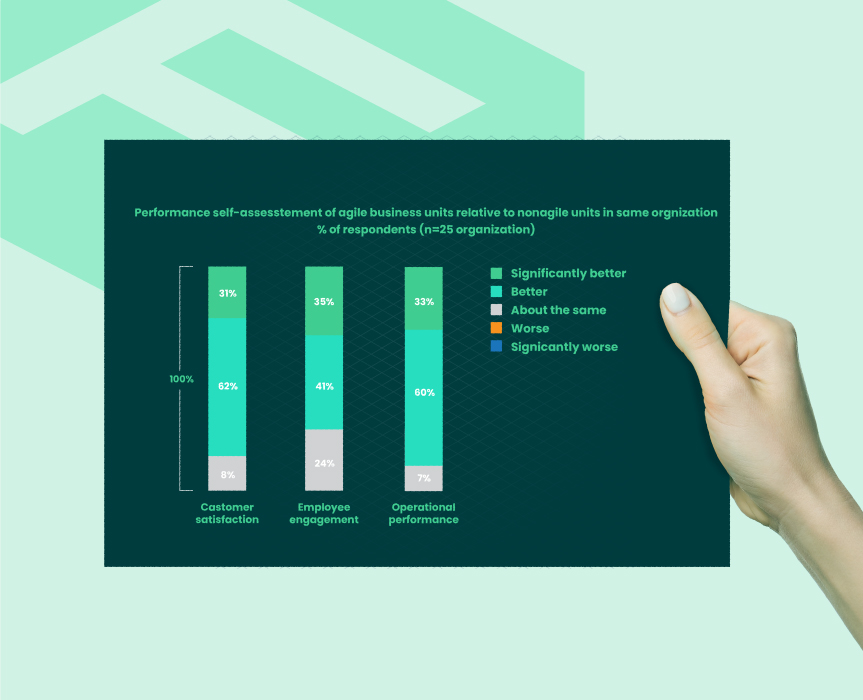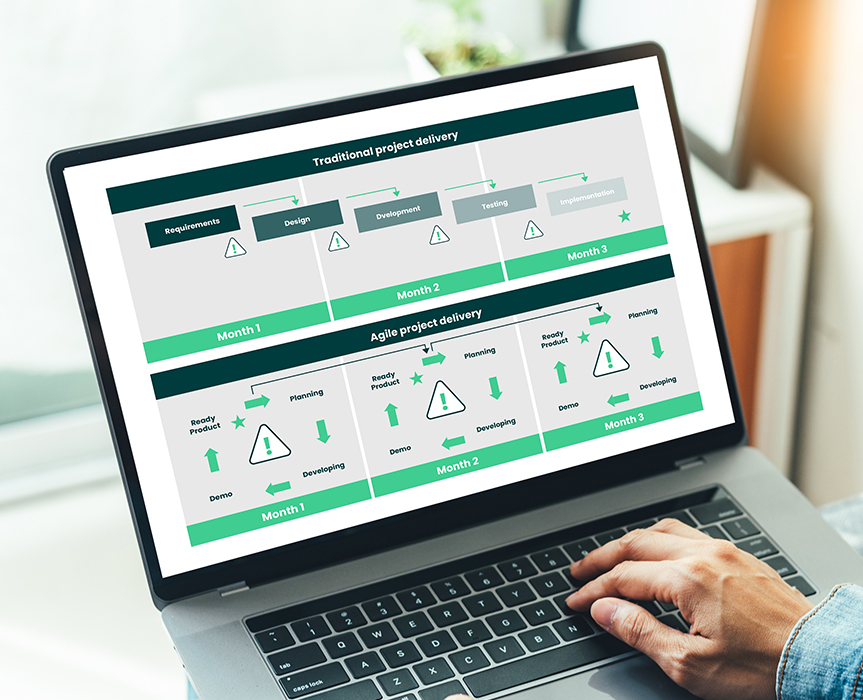Nowadays, more and more companies invest in Agile project management software and tools across industries. Originating from the Agile Manifesto in 2001 by 17 independent-minded software practitioners, Agile methodology has intensified its demand over the years and is rapidly accelerating due to the COVID-19 pandemic.
To quickly adapt to changing business priorities and cope with pandemic challenges, many companies have stepped toward the path of agile practices. It helps them be more fast, resilient, and flexible. As per McKinsey analysis conducted among 25 companies who had fully adopted an Agile model before COVID, 93% of business units increased their operational performance compared to their peers who hadn’t adopted it.
According to the Capterra survey on Agile project management software among 300 Agile PM software users, the three top drivers for investing are project visibility (70%), ability to plan (74%), and team productivity (71%). According to this report, the most adopted industries belong to IT teams, engineering, and project/product management teams.
The reason why Agile organizations outperform non-agile companies lies in the ability to align to updated priorities, fast and effective decision-making, accelerated software delivery, reduced project risks, etc.
Before moving to explain how to create effective Agile software development teams, let’s first see what the roles and responsibilities of each member of the team are, the pros and cons of each approach, and what the Agile process looks like.
Software Development Team Approaches
Considering that the Agile process is iterative, it involves different team members who fulfill their specific tasks. Each team member’s role varies and depends on the goal of a particular project sprint. Let’s take a look at the ways how you can arrange your Agile product team.
Generalists
In the Agile team structure, team members have diverse awareness and knowledge. Therefore, they can perform various tasks and have a clear vision of the whole project. As a result, this approach is the most used one among outsourcing companies.
Pros:
- Each team member is knowledgeable and can contribute to improving the entire project.
- Everyone has enough expertise to work on the projects independently and still be involved in other tasks.
Cons:
- Even if generalists have versatile skills, they may lack specific knowledge, so new team members have to be involved in the process.
Specialists
This approach involves team members with specific skills who can manage narrowly focused projects. Specialists have profound experience in managing highly specialized project elements.
Pros:
- A deep understanding of the separate parts of a project helps quickly build high-quality products.
- Each member’s responsibilities are clearly defined.
- Specialists can handle tasks of advanced complexity.
Cons:
- Individual distribution of responsibilities can harm holistic problem-solving.
- Due to the lack of common knowledge, there can be communication gaps that can require improved workflow coordination.
Hybrid
The hybrid approach implies the combination of specialists who can be focused on specific parts of a project and generalists who can take care of the project as a whole. The Agile team structure is a perfect fit for any type of project, including complex ones.
Pros:
- High level of flexibility and efficiency
- Enhanced productivity
Cons:
- Building such a type of team requires a lot of time and expenditure.
How Does an Agile Software Development Process Differ from the Traditional One?
Teams that follow a traditional set of principles and values toward project delivery adhere to a strong hierarchical structure and clear role distribution. Meantime, agile-driven values are oriented toward smooth workflow coordination that is almost free of supervision. But it doesn’t mean that the responsibilities of Agile teams are not well-defined.
Applying iteration in the product development process, Agile teams break down typical long project cycles into small 4-week sprints. During the iteration, Agile teams develop small segments to achieve a working product that is tested each month. In this way, the product is continuously iterated and tested. Such an approach helps permanently work on getting feedback and improving the product throughout the cycle, not waiting till the implementation stage (as it is done with traditional project delivery).
That’s how it looks visually.
The iterative Agile approach allows projects to be less complex and flexible, significantly increasing visibility and reducing risks. With that said, you need to understand that continuous improvement and early elaborations upon a product enable development teams to respond to threats at the early stages. This, in turn, impacts the teams’ efficiency and mitigates the opportunity of final product failure. There are still risks, but they can be prevented earlier thanks to a transparent project model.
| Agile | Traditional | |
| Team management | Self-organizing teams with a PM who coordinates the team | Unwavering hierarchical structure |
| Team roles | A mixture of multipurpose teams | Precise role and duties responsibilities |
| Values | The whole team’s performance | Individual metrics of each member |
| Team performance | 100% dedicated to the project | multitasking |
| Delivery model | Four-week sprints with continuous iterations and testing | The long cycle of product implementation |
| Team size | Limitless | 3-10 people per team |
What Are the Roles in Agile Software Development Teams?
Within the Agile team structure, product performance and final results depend on the flexibility and transparency of the workflow. Even if team members can perform various tasks, their roles are clearly distributed within the development sprint.
Business Analyst
A business analyst is a person who conducts in-depth market research and analyzes the business domain, sets up business goals, and outlines business requirements, ensuring the business model coherence with the technology. The primary role of BA is to facilitate the relationships between a customer and a team. The ultimate result of BA’s work lies in specifications and SRS documentation at each stage of product development.
Product Owner
Product owners are usually positioned as representatives from product companies or product managers on behalf of the company. They are responsible for the value a product brings to the market and the culture in the collaboration between teams. Product owners ensure that all essential features are included in the product development.
Project Manager (Scrum Master/Team Lead)
This person is in charge of the successful implementation of a project. PM’s main goal lies in planning and execution. Project managers are responsible for process planning, generating reports, monitoring deliverables, and setting up communication meetings between team members. Being a mediator between a technical team and a client, project managers need to have a unique perspective of the project process, considering business requirements and technical specifics. They play an essential role in problem-solving and translating complex technical concepts into the client’s business language.
UX/UI Designer
The roles of user experience and user interface designers are tightly connected and, at the same time, differ in terms of their purpose. UX designers’ responsibilities encompass the fundamental aspects of the interaction with the customers, ensuring a meaningful and relevant experience for the users. Therefore, UX ecommerce designers are focused not only on creating usable products with excellent user experience but also on coming up with ideas on how to efficiently meet their needs even before the product goes into the user’s hands. UI designers are in charge of ensuring the product’s aesthetic, visual touchpoints, and interactivity.
Front-end/Back-end Developer
While front-end developers focus on the client-side part of a product and the smooth interaction of an app with the user, back-end developers are responsible for application logic and functionality. Front-end developers take care of seamless user experiences without constraints since different devices, browsers, and operating systems require different resolutions. Proficient back-end developers not only write codes but also build entire app architecture and are responsible for databases and server communication, API, and external integrations, paying great attention to the security of the digital product.
Quality Assurance Engineer
QAs identify bugs and issues before the app gets to the user. The main task of QA is to test the application’s performance and security, user experience, and usability. Moreover, testing is not the only goal of quality assurance engineers. They are also responsible for the holistic fulfillment of project requirements, covering documentation, technical specs, quality standards, etc.
How Does an Effective Software Development Team Look Like?
Hiring skilled and tech-savvy employees is just a part of the goal of building a software development team. The organization of solid collaborative environments and capacity-building efforts is not less important. It is the number one task for product owners. We outlined the main points that motivate the Agile software development team to achieve high results.
- Healthy communication climate. Since Agile teams are self-organizing, their communication must be comfortable, ensuring face-to-face interactions via daily standups or meetings.
- Inclusive corporate culture. Integrity and dedication are the cornerstone of a thriving corporate culture where employees are willing to work together and support each other on each project step. There is no supervisor and hierarchical management model. Hence, mutual values such as transparency, continuous improvement, experience sharing, etc., are the drivers of a self-sustaining environment in the company. If you want to hire a dedicated full-fledged development team, let us know – we will help accommodate the top-notch specialists.
- Shared mission. To empower talents to achieve better results, it is of high importance to facilitate their contribution to the project as a whole. That is, if everyone contributes to the success of the whole team (not for themselves), efforts are multiplied. The value of each person in the team is estimated equally since each member is an integral part of shared achievement.
- Clear roles and responsibilities. From the start of the project team’s roles are well-defined, and a common goal is set so there is smooth cooperation and a high level of motivation.
Want to know how dedicated teams can facilitate business growth and expansion?
Check our case study on how a dedicated team helped the client optimize the online retail store!
Your Path to Agile Project Delivery: Tips
To embrace Agile transformation, your company must be ready for cross-team communication and evaluate its maturity. Recapping all the information mentioned above, we compiled a brief list of tips. Read our recommendations on how to properly arrange the agile team structure of your software development team to unleash your company’s potential.
Determine the approach of the software development team
What type of development team to select (generalists, specialists, hybrid) depends on the client’s requirements, project type, and size.
Set defined roles and responsibilities
Clear distribution of the roles of each member within a project will foster the team’s efficiency and, consequently, the overall performance of the project.
Define a product roadmap
Based on the client’s requirements and business needs, a product owner collaborates with other team members to create a roadmap with milestones.
Select Agile methodology
The most popular ones are Scrum and Kanban.
Maintain continuous interaction with product clients
This principle allows Agile teams to present transparency of the workflows and establish solid and credible relationships. Clients and stakeholders are invited regularly to meetings to review and analyze the work done within such an approach.
Conclusion
To successfully implement the idea of the software product, you need to decide what type of development team you have to build. Maybe, generalists will best suit your specific project requiring versatile awareness and knowledge, or specialists who can handle projects with advanced complexity. If your budget opportunities are not limited, hybrid teams can even be more beneficial. Once you organize a team, you can move forward with defining roles and responsibilities. Maintaining a healthy team’s microclimate, openness, and continuous communication within and outside the company is the backbone for the effective and streamlined implementation of software development projects.

Our Engineers
Can Help
Are you ready to discover all benefits of running a business in the digital era?

Our Engineers
Can Help
Are you ready to discover all benefits of running a business in the digital era?









